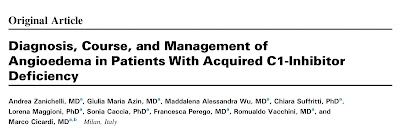The Role of Baked Egg and Milk in the Diets of Allergic Children. Fecha: Lunes 1 de octubre de 2018
The Role of Baked Egg and Milk in the Diets of Allergic Children Authors: Robinson ML , Department of Pediatrics, National Jewish Health, 1400 Jackson Street, K830, Denver, CO 80206, USA; Department of Pediatrics, University of Colorado School of Medicine, Aurora, CO, USA. Electronic address: Robinsonm2@njhealth.org. Lanser BJ , Department of Pediatrics, University of Colorado School of Medicine, Aurora, CO, USA; Department of Pediatrics, Division of Allergy and Clinical Immunology, National Jewish Health, 1400 Jackson Street, J322, Denver, CO 80206, USA. Abstract: Baked egg and baked milk are tolerated by most children who are allergic to hen's egg and cow's milk . Incorporating baked goods into the diets of allergic children may help them outgrow their primary allergy more quickly, with changes observed akin to immunotherapy. Benefits ...

